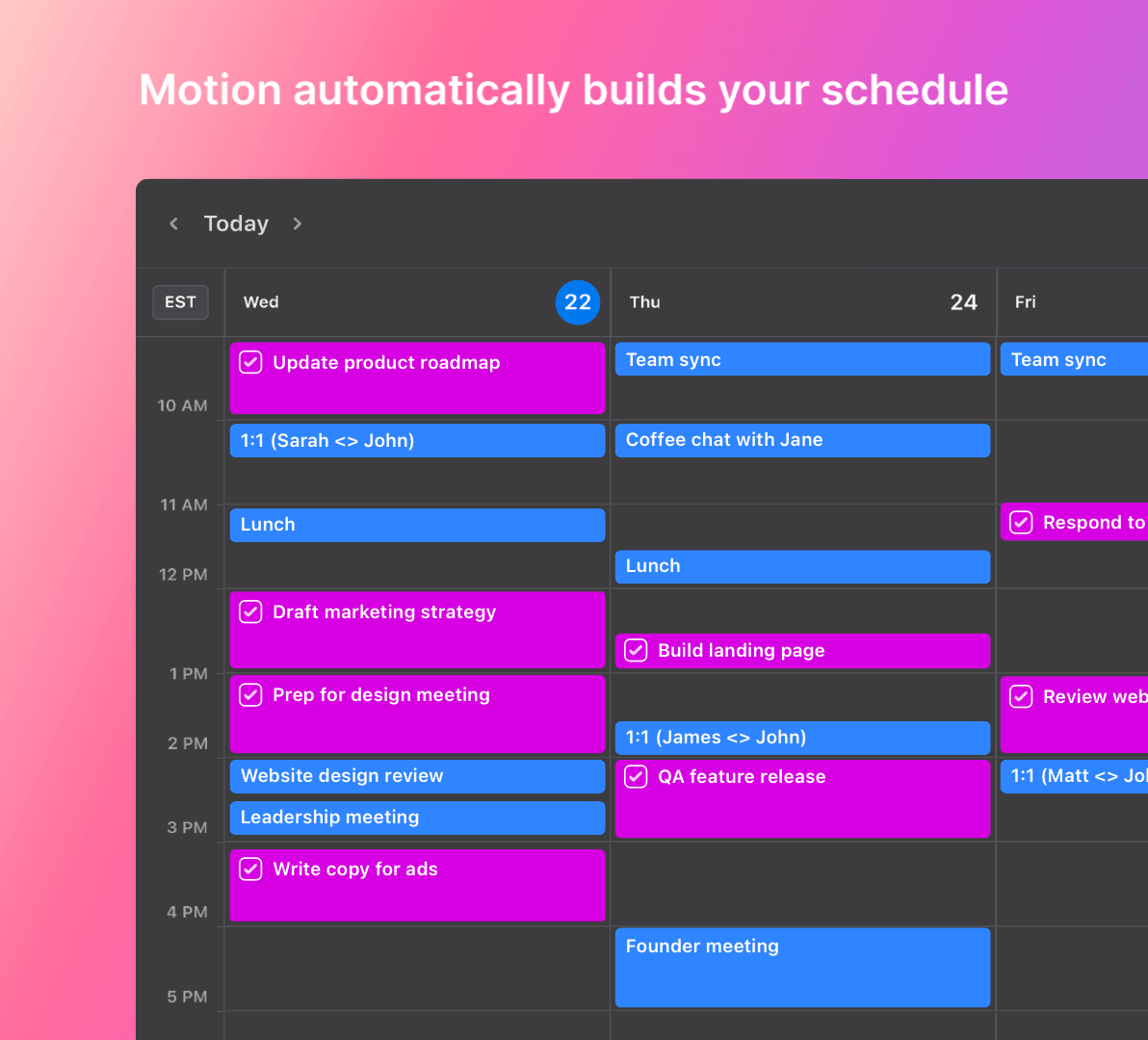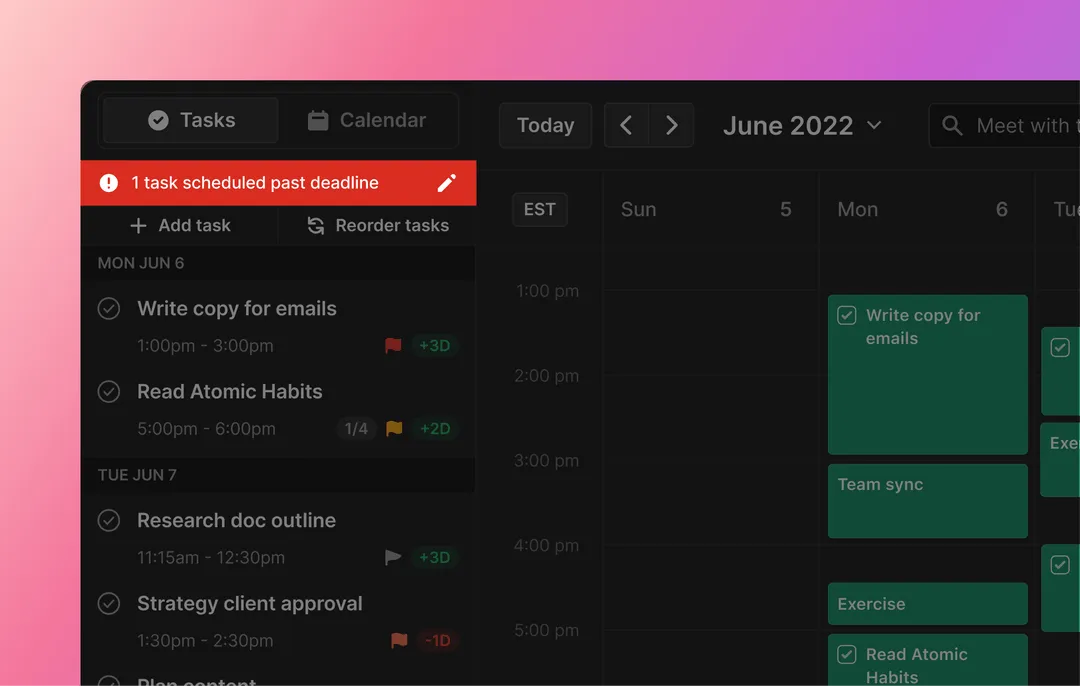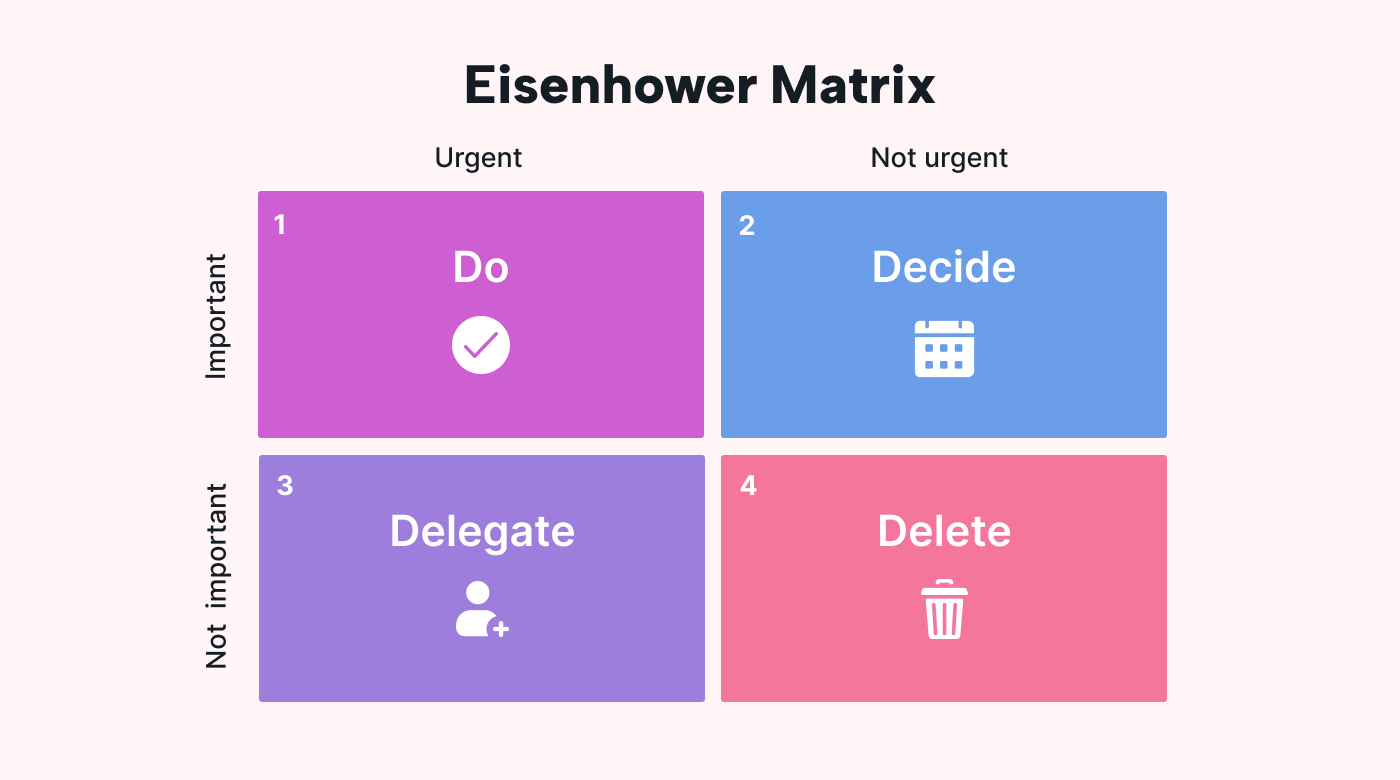Is time management your Achilles heel? Are you stressed from all the things you haven't even started to think about yet? Ever feel like you need 48 hours in a day instead of just 24 to get things done?
Don't worry. You're not alone.
Managing our time correctly is more important than ever as our days get busier. We need to sleep and eat, too, not to mention tend to our personal lives. After all, we're only human.
This article will show you 12 time management strategies to boost your productivity, leaving you more time to spend on doing things you want to do.
Let’s get started.
What is time management?
Time management is the practice of using your available time effectively, efficiently, and productively, often on specific tasks. It involves planning or scheduling and plenty of self-control. If done correctly, it can free up more time for you to spend on something you enjoy.
Why is time management important?
82% of people don’t have a time management system, which is surprising since time management is essential for many reasons. Here are just a few of them:
- You do more in less time.
- You’re more productive. 44% of employees reported being most productive in the early morning, while 31% said they were more productive in the late morning. After that, productivity dips. Time management allows you to take advantage of your most productive times so you can do your best work.
- You’re less stressed. One in eight people feels that their work is never under control. Effective time management strategies make you less stressed and more in control at work and in life.
- You meet deadlines more consistently.
- You won’t feel stuck as often. You'll understand the priority of your tasks, so you won't be distracted by low-value tasks that add no value to your work or life.
- You have more energy. Knowing your time and energy levels allows you to schedule things strategically so you don’t burn out as often.
7 strategies for effective time management
Now that you know what time management is and why it’s so important, here’s a list of seven effective time management strategies for you to try. Choose the ones that work best with your personality, self-motivation abilities, and how self-disciplined you are.
1. Plan your day
According to author Brian Tracy in his book, “Eat That Frog!”, spending 10–12 minutes planning your day can save you two hours each day.
The simplest way to do this is by using a to-do list. You can use a physical paper list or a digital app, but make sure to cross out each item after you’ve done it to have a sense of accomplishment.
Another way is to schedule your tasks in your calendar, physical or digital. Motion can help with that.
 |
2. Prioritize
Now that you have your to-do list, it’s time to prioritize your tasks in order of importance and urgency.
Although there are many ways to do this, an excellent way to get started is to pick out the most important tasks and do them first.
Another way is to sort tasks into three groups based on their importance — high, medium, or low. If you want to get ahead, you can do this for your daily, weekly, and even monthly tasks.
3. Limit distractions
If high-priority tasks are like vegetables, then distractions are like junk food — tasty, easily found, and not very nutritious. That's why limiting distractions is crucial, if not removing them outright.
Distractions include smartphones, the internet, email, social media, meetings (unless it’s a necessary meeting), and co-workers.
There are many ways of limiting distractions. You can put your phone on silent while working on your most important tasks, block social media on all devices, and turn off notifications for text, apps, and email. Also, consider using noise-canceling headphones to block out unwanted sounds.
4. Avoid multitasking
Contrary to popular belief, multitasking doesn't help you get things done quicker. In fact, the opposite is true.
Research has found that those who multitask engage in something called ‘task switching,’ which places more demands on their mind. That slows you down and makes you less efficient.
Do one thing at a time to maintain focus, and you’ll be more productive.
5. Delegate
Is there something you need to do but don’t have the time or skill for? Is there someone who can do it better than you? If so, delegate it to them.
Delegation frees up some time for you to handle tasks that truly need your input, and usually, the cost is worth it.
For example, can you hand off tasks to your team or share them with a co-worker? Are there things you can outsource?
Of course, you should let them attend to the task without micromanaging them. That defeats the whole purpose of delegation and adds more to your plate, which is the last thing you want!
6. Use time management tools
There are a lot of time management tools out there that can save you time and make you more productive. They’re roughly divided into four categories — time trackers, productivity apps, task managers, and project management tools.
Time trackers allow you to see how you spend your time, as well as the time it takes for you to complete a task. They can help you get a more accurate picture of how long something takes to do so you know for future reference.
Productivity apps limit distractions or help you break time-wasting habits. Usually, they’ll block access to unproductive things (like certain websites or apps) for a user-specified amount of time or help you start productive habits.
Task managers help you organize your time more productively and include features like to-do lists, planners, and calendars.
Project management tools take it one step further by allowing you to manage entire projects in one place. They usually come with most of the other time management tools embedded, such as time trackers and task managers.
 |
Motion, for example, comes with a very robust online calendar that integrates seamlessly into its project management functionality. As soon as you’re assigned a task, it’s added straight to the calendar without you having to tinker with it manually. It also comes with notes, checklists, and a banner that reminds you to focus on your task.
7. Take time to recharge
While it's great to be productive, knowing when to take a break is vital. After all, humans can only work so long, and a good night's rest helps us do better the next day.
Don't just take my word for it, however. Microsoft found that breaks between meetings allow the brain to reset, lowering participants' stress levels.
And it's more than just taking breaks from meetings (although back-to-back meetings are not the best idea). Taking some time to relax can energize you and improve your focus once you’re ready to work.
5 time management techniques to supercharge your productivity
While the seven strategies above are a great way to start, the time management techniques below will supercharge your productivity. Give them a try and see how they work for you.
1. Time blocking
Time blocking does exactly what it says — you carve out blocks of time and assign certain tasks to that spot in your schedule.
It’s a bit like being back at school, where everything is planned for you, including when and how long you take your lunch. Except for this time, you’re the one doing the planning.
For example, say you want to work on some illustrations from 10 am to 11:30 am. Then you want to grab lunch from 11:30 am to 12 pm. You'll schedule each task in your calendar at their respective time slots and do the same for all the other tasks you want to complete that day.
But what if something changes? If you’ve been manually adding tasks to your calendar, you’ll have to shift them around and re-plan everything, which is quite the hassle. So that’s one downside of this technique.
Fortunately, it doesn’t have to be that way.
Motion takes time blocking to a whole new level. If something on your schedule suddenly changes, Motion automatically reshuffles everything on your calendar without the need to do it yourself. What a time saver!
 |
2. Pomodoro Technique
Francesco Cirillo created the Pomodoro Technique when he was a student in 1987, studying for the sociology exam.
He couldn't focus and was constantly distracted. So, he went to the kitchen and grabbed a timer; the rest is history. As he says, "...the ideal unit of work was 25 minutes followed by a 2–5 minute break."
And that’s how the Pomodoro Technique works.
Pick something you want to do. Let's say you want to get some writing done. Use a timer and set it to 25 minutes. Do your writing during those 25 minutes, and when the timer beeps, set it to 2-5 minutes and take a break.
As you go along, you can play around with the timing of the tasks and the breaks. It’s a good way to schedule breaks so you don’t burn yourself out.
3. 80/20 rule
The 80/20 rule says that 80% of your results come from just 20% of your efforts.
Created by Italian economist Vilfredo Pareto, the goal of the 80/20 rule is to get you to prioritize work with the highest impact on your workday instead of time wasters. Here’s how to do it:
Write down a list of tasks you must do on any given day, week, or month. Start with a day for now. Then look at your written tasks and determine which ones have the most significant impact.
For example, is there a big project that needs all hands on deck? Is there a massive problem you need to solve immediately? Is doing this task going to make your life much easier from this point forward?
If so, work on those tasks first.
4. Eisenhower matrix
The Eisenhower matrix is another successful technique for time management.
Named after American President Dwight Eisenhower, the guy who invented it, the Eisenhower matrix (or urgent-important matrix) separates tasks into four quadrants in order of importance and urgency. Here’s how to do it:
 |
Draw a square and separate them into four smaller squares.
In the top left box, write ‘Urgent.’ In the top right box, write ‘Not Urgent.’ Next, write ‘Important’ next to the top left box and ‘Not important’ next to the bottom left box. Then categorize all your tasks in the boxes.
Do all tasks marked as urgent and important first. Schedule a time to do tasks marked as not urgent but important. Delegate urgent and unimportant tasks, and delete tasks that aren't urgent or important.
5. Rapid planning method (RPM)
Motivational speaker Tony Robbins created RPM to redirect your energies towards outcomes you care about the most. According to him, RPM stands for “results-oriented, purpose-driven, massive-action plan.” Here’s how it works:
First, you’ll have to determine the result you want to achieve. Then ask yourself why you want to achieve that result. Why is it so important to you? That’s the driving force behind your actions.
After that, write down a list of actions you need to take to achieve that result. Not just one or two things — everything you need to do. Everything.
Now that your plan is appropriately massive, looking at it is bound to give you a heart attack. Okay, maybe that’s too dramatic, but it’ll surely overwhelm you if you try to do it all at once.
So don’t. Group similar tasks into smaller chunks and work on each task one chunk at a time. It’s much easier for your mind to digest and makes it easier for you to get started too.
Give yourself the gift of time with these time management strategies
Let’s face it. You only have 24 hours a day. While you can’t be productive for all of them (hey, you’ve got to sleep sometime), you can minimize the hours spent doing work tasks with some effective time management strategies. That leaves you more time to do the things that matter to you.
To make things better, Motion helps you save even more time by reducing manual planning. It’ll prioritize things for you, guard your time so you work uninterrupted, and ensure you meet your deadlines.
Give yourself the gift of time with Motion’s 7-day free trial.





